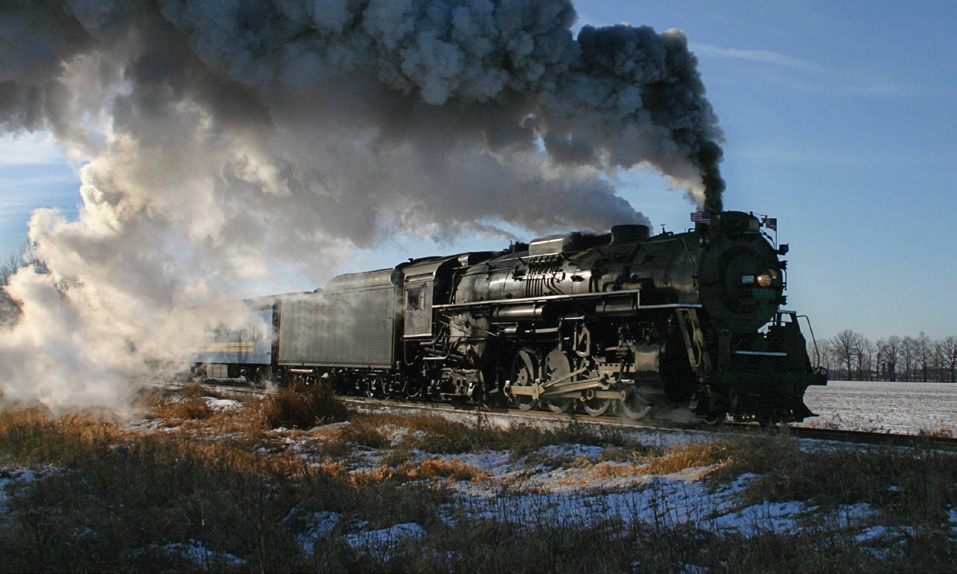Now boarding: The tribology train
Edward P. Salek, CAE, Executive Director | TLT Headquarters Report December 2018
From yesterday's steam locomotives to tomorrow's electric cars, our science is the technology that enables progress.

Despite the best efforts of an earlier generation of tribologists, steam-powered locomotives from the mid-1900s had problems with energy efficiency and environmental impact.
steam-locomotive-©megapixl-3216080
Family outings on an autumn Sunday afternoon create wonderful memories, and sometimes they also inspire a magazine column.
That’s what happened a few weeks ago when the Saleks visited the Illinois Railway Museum (IRM) about 60 miles northwest of Chicago. The IRM was founded in 1953 and has grown to become the largest collection of preserved railway and transit equipment in North America. The museum’s site features 450 pieces of equipment stored in exhibit buildings and historic structures on some 100 acres of property.
One of the buildings houses a collection of 25 vintage steam locomotives, which now sit silent but not too long ago puffed and roared across the U.S. and Canada at speeds that sometimes topped 100 miles an hour. Walking through the exhibit gives a visitor a perspective on just how big these machines were and how much complicated design and engineering went into each unit. It also piqued my curiosity about how tribology enabled this technology to flourish for a period of time and why the era of steam-powered trains in North America ended in the 1950s.
The answer to the second part of that question is fairly straightforward. Steam locomotives were dramatically inefficient users of energy. A typical steam locomotive had a thermal efficiency of only about 6%—six BTUs of horsepower were produced for every 100 BTUs of coal burned. Modern diesel engines achieve almost 36% efficiency. Steam locomotives also required high maintenance and labor to keep them operational and were not exactly environmentally friendly.
While the steam era did not last long, it’s clear that when this was a dominant form of transportation, the technology improved thanks to the application of tribological principles. Numerous researchers, engineers and technicians were behind these developments. One name that stands out in Internet searches is Livio Dante Porta, an Argentinean steam locomotive engineer who worked during the last century. He is particularly remembered for his innovative modifications to existing locomotive systems to obtain higher performance, energy efficiency and reduced pollution.
The study of wheel-rail interface tribology, another crucial factor in railroading regardless of the power source for the train, also has contributed to efficiency and safe operations. This topic continues to be studied by working groups from the U.S. and Europe seeking to develop standards for railroad lubrication systems.
Steam engine technology might live in a museum, but tribology remains at the forefront of the transportation field, which is expected to grapple with continued change for years to come, according to the STLE 2017 Report on Emerging Issues and Trends in Tribology and Lubrication Engineering, available for free at
www.stle.org.
Out of a list of 20 transportation-related trends and technologies, the report identifies the most significant as high-efficiency vehicles, pure-electric vehicles, self-driving autonomous vehicles, lower-viscosity motor oils, hybrid-electric vehicles and low-emissions vehicles. Overall, many of the top trends in transportation relate to efficiency through electric power. The full impact of this trend on tribology and lubrication engineering is unknown.
However, as one expert observed in the report: “Many think electric cars will mean less tribology, but it may bring (the field) to the center of things.”
While the future of tribology in transportation might be somewhat unclear, there’s no doubt that tribology and lubricants will continue to be a prime enabler of a variety of future technological advances. What’s also certain is that STLE will continue to follow and report these trends as part of our commitment to be the global advocate for tribology and lubrication technology.
You can reach Certified Association Executive Ed Salek at esalek@stle.org.